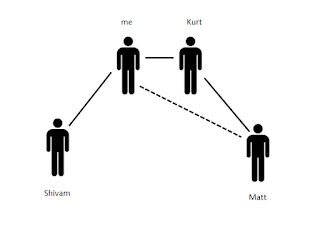- Day One: Present to a team of 3 of the university's College of Business faculty members
- Day Two: Present to a panel of 5 professionals from various consulting organizations
My team was composed of two friends of mine, Shivam and Kurt, and then Kurt's friend Matt who I had an acquaintences relationship with. Shivam had never met Kurt or Matt, so the relationship between them was casual as project partners. I created the following "relationship chart", similiar to an organizational chart to help understand the relationship of the group dynamic as opposed to a team dynamic.
Since Shivam is from California and Kurt is from Georgia, we had to initially work on the project over winter break via conference calls. It was difficult at first because there wasn't a solid relationship between the group. It was what Katzenbach and Smith would refer to as a group, not a team. We would all present our research we had done those past few days and then review the analysis. However, there wasn't a sense of open collaboration because there was no relationship foundation. Having a virtual team structure was difficult and Kurt had attempted to take a leadership role. It was difficult for the group to respect that though since we were unable to have face to face interactions and there was no clear "team leader" role that needed to be defined.
We came back to campus and finally met for the first time to pull together the presentation. To be honest, it started off as incredibly awkward. Kurt tended to dominate the group, Matt was a second semester senior who just wanted to finish the case competition, Shivam did not appreciate Kurt's dominating attitude, and I struggled to balance large amounts of work with the demand of the case competition. After a few late nights of putting in research and fighting over whose analysis was best, we finally started to migrate from a group to a team.
It seemed odd that the group would form a team working hard late at night, but its exactly what Katzenbach and Smith touch on. Teams come together when you put time and effort into forming a team structure that works. We would take breaks from working to order takeout and show each other new music and one night we stopped working early and took a trip to Red Lion together. After developing a social relationship, we were able to start actually working together as a team.
The quality of slides, analysis, and effort greatly increased when we came together because we felt accountable to each other. The difference was clear in our performance. The initial slide deck we had created from our phone calls had greatly improved due to the quality of work we were all putting in. It showed too: we moved on from day one to the final rounds day two where only three teams presented to the final panel of professionals.
We recieved third place (I blame it on competiting against two other teams of all MBAs...), but we had definetly developed the strongest sense of team dynamic. One of the final round judges came over during awards and asked us how we knew each other. When we explained our relationship, he said it was clear that we were all close because our performance had the most evidence of a team relationship. Our presentation skills were stronger because we were able to bounce off each other and our recommendation had come together as a result of mutual effort from everyone on our team.
The key take away from this project that relates to Katzenbach and Smith is that team structures develop from groups as a result of individuals whose contribution is made to further group performance. They don't evaluate success based on how well they do, but they work hard to deliver a successful result for the entire group. They don't have the mentality of "I do everything for this group", instead they think "I am doing extra to help the group". This was a project focused group: the case competition was our project and we were working to meet that performance. The success of the case competition that led us to final rounds was a result of the time spent not only on the project but as developing ourselves as a team outside of the project. An updated relationship chart representing the team dynamic can be seen below.

